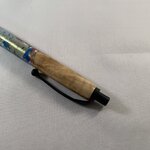Mongo44
Member
Hello, I have recently started making pens and pencils. Over the past month I have developed my method for finishing (2 coats of thin CA & 8 coats of medium CA), followed by micro mesh, and then plastic polish. This often given a beautiful finish, but seems too affect my transition from kit components to blank. This could also be my fault by not turning the blank down enough. I have a square carbide rougher, round carbide tool, and diamond "detailing" tool. Usually Ill use the square rougher to get as close as possible to the bushings, then take light passes with the rounded tool. Followed by 180-600 sanding, at this point it usually appears to me that my blank is even with the bushings. Yet, once I assemble the pen after finishing I often notice the slightest overhang from blank to cap, center band or nib. Any tips to help get the blanks perfectly lined up with the bushings so there is a seamless transition. Here are pictures showing what I am referring to. Thank you all for the time and help, I'm excited to learn!


